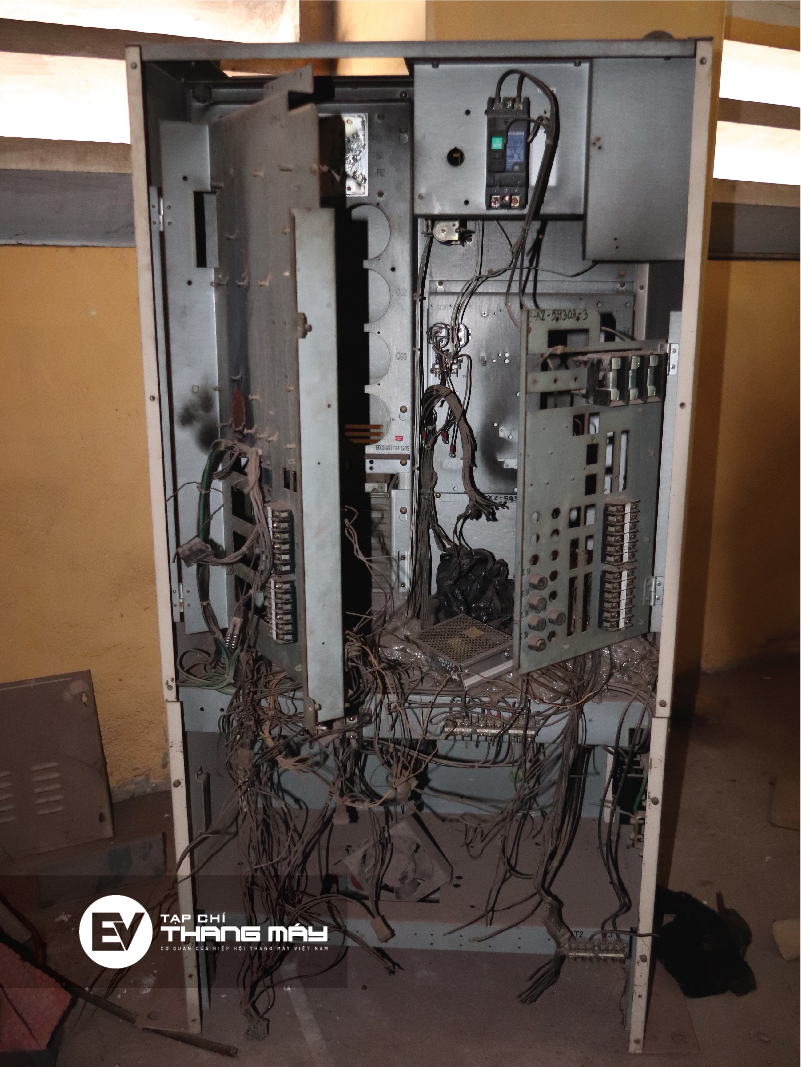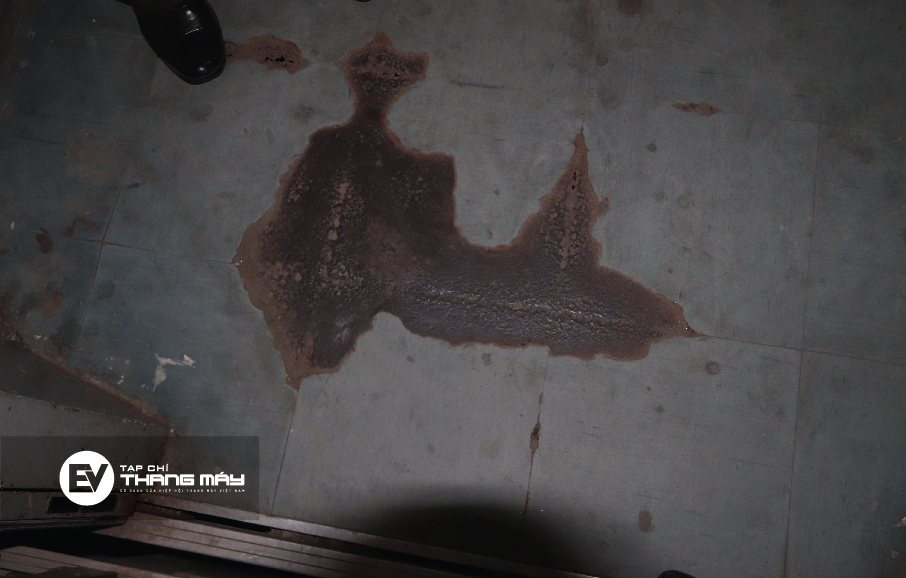We will miss the opportunity to change the situation and improve apartment elevator safety if we continue to be indifferent to the causes.
Equipment quality – a prerequisite
The control cabinet is empty, the cabin has lost its roof, the Intercom system and the rescue bell are not working, etc. The images of the seriously degraded elevators of house G, the resettlement area of Den Lu mentioned by Elevator Magazine. Mentioned in the article “Episode 1: Frustrated with a way back” is only a very small part of the reality of the apartment elevator being exposed.
From the newly installed massive elevator systems, many have now no longer working in apartment buildings throughout Hanoi, raising questions about the quality of equipment, the origin of product.
This problem is completely sound and likely to happen because so far there are many limitations in the application of standards from: design, production, installation, maintenance, repair, upgrading,… elevators. According to the Department of Occupational Safety, in recent years, each year, over 35,000 elevators are put into use and over 1.7 million elevator equipment for domestic production and assembly is imported into Vietnam. Not a small number at all.
According to Articles 3.1.2 and 3.1.4 National Technical Regulation on Occupational Safety for Elevators (QCVN 02:2019/BLDTBXH) issued together with the Ministry’s Circular No. 42/2019/TT-BLDTB&XH Before being put on the market, elevators must be certified in accordance with the standards by a certification organization designated or recognized by the Ministry of Labour, Invalids and Social Affairs, must declare conformity according to regulations, and be subject to regulatory approval. inspection and supervision by product and goods quality inspection agencies. However, in practice, testing products for an overall assessment is very difficult to do due to many reasons, one of which is the lack of specialized equipment and human resources.
So if the quality of origin is guaranteed when new installation, why does the elevator fail quickly? In fact, in addition to 60% of equipment factors that determine product durability, the remaining 40% depends on many other factors such as installation, maintenance, user awareness, etc.
Installation, maintenance and maintenance of elevators are still “bottlenecks”
“No matter how good an elevator is, if it is not installed in accordance with the design regulations, it will not be able to operate smoothly and certainly not ensure safety.” – Mr. Nguyen Duc Tien, technical expert of the Technical Service Center of Vietnam Elevator Association.
In the process reporter working, collecting and verifying information, the elevator system in the resettlement area of Den Lu, Hoang Mai, Hanoi was originally genuine elevators. You have to witness the actual situation after 17 years of use to see the terrible devastation. And how many apartment elevators have suffered the same fate that has yet to be exposed.

The empty electrical cabinet in the elevator has been broken for many years, raising the question of where do the components go after the maintenance?
To install a safe operating elevator system, it is necessary to have knowledge, professionalism and technical compliance. After that, the elevator needs to be properly maintained according to regulations. However, in fact, in the elevator market, there are many installation, maintenance firm operating in a small and fragmented model. Equipment is assembled lack of synchronization, substandard. During operation, repairing and maintenance: the risk of swapping and replacing equipment, causing equipment to fail due to purpose or poor qualifications is not uncommon.
Thereby, one of the issues worthy of attention is the capacity of the labor force in the elevator industry. Elevator engineering currently does not have a job code, which means that there is no specialized training program for the elevator industry, but mainly human resources from other technical disciplines move to
Strict standards will create a filter to evaluate and select a workforce that meets the professional and ethical requirements of the elevator industry. It is time for an industry directly related to human life such as elevators to build a set of professional certificates, besides industries: medical examination and treatment, construction, veterinary medicine, …
Building management: an important link
The incident of a young girl who unfortunately fell into the well from the 7th floor (Kim Ma, Hanoi, October 2021), the elevator suddenly fell freely from the 5th floor, causing many people to panic and injured (apartment) B10A Nam Trung Yen, November 2020), the man who did not survive when he fell from the elevator (Yen Hoa, Hanoi, 2011),… rang the alarm bells about elevator safety, especially elevator rescue.
In addition to enterprises that employ workers directly involved in the installation, maintenance and repair of elevators, the apartment building operator (Building Management Board) should pay special attention to strict conditions, which are strictly regulated. training in elevator operation, rescue and safety techniques. According to Article 3.4.4 of Circular No. 42/2019/TT-BLDTBXH: Organizations and individuals that manage elevators installed in apartment buildings must assign at least 01 person to be responsible for elevator operation. This person must be trained in elevator safety and plans for handling emergency situations related to elevators. However, in fact, many apartment management boards still do not meet this standard. For example, the Building Management Board of Den Lu Resettlement Area since 2008 has not been trained in elevator operation and safety since 2008.
It’s time to have a stricter sanction, to ensure the regulation is put into practice, should workers related to elevator safety need a training certificate instead of just training courses.
User responsibility should also be taken into consideration.
How to use the elevator is also one of the important reasons to ensure the durability and safety features of the equipment.
Apartment dwellers must be no surprise at the image of women using the elevator to coax children to eat and play. Using the elevator to go up and down continuously, selecting all floors, … then playing and bumping on the door, on the wall of the cabin all cause the elevator to fail quicker. Children are like that, even adults have shameful behaviors. Searching for the keyword “pee in the elevator” on the Internet returns results that readers don’t know whether to laugh or frown and wonder about the cultural and civilized level of urban people! Then people throw trash, wipe the floor to make water run down the shaft, etc. All those seemingly rare things have become commonplace with elevators in apartment buildings and buildings.

Rust stains on elevator cabin floor due to infiltration of harmful liquids, Den Lu Resettlement Area, Hoang Mai, Hanoi
In addition, the understanding of the vast majority of users about elevators is still not enough for urgent situations. “Elevator user manual” is mostly known to people who don’t know, but special features such as Intercom button, emergency bell, Emcall, etc. are not known by many people. When the incident happened, many people did not have enough knowledge to use the features equipped in the elevator, instead they tried to pry open the cabin door, repeatedly banging on the door, wall, etc. Therefore, training to user is also a matter need to be addressed.
Gap in inspection work
Elevator inspection is also a matter to seriously consider. According to statistics, every year 40,000 elevators are inspected, more than 130 organizations are licensed to conduct inspection with the number of inspectors approximately 1000 people. In fact, the criteria and time for re-examination are quite unclear.
The policy of socialization in inspection has created opportunities for several enterprises to register for the service of technical inspection of elevator safety, increasing competitiveness and creating favorable conditions for society. However, the quality control of those units’ operations is another matter.
Newly installed elevators must be inspected and stamped for safety before being put into use. But with the elevator already in operation, the inspection depends a lot on the subjective consciousness of the management unit. If the fire prevention and fighting work, the fire police will come to check and accept whether the equipment is qualified or not, periodically re-check, but the elevator does not have post-inspection work, not a lot of work. The program has been used for decades but has not been verified.
At Den Lu Resettlement Area, the elevator system was last inspected in March 2021. As of 11/12/2021, 20 elevators are not up to standard but still operate. When the elderly, veterans, pregnant women still have to struggle to ride on the ‘machines without brakes’, when will the safety of elevator stops to have problem?
Is there any other reason behind the unsafe situation of this apartment elevator? Elevator Magazine will inform readers in the next issue.
Quoc Hung – Hien Minh



